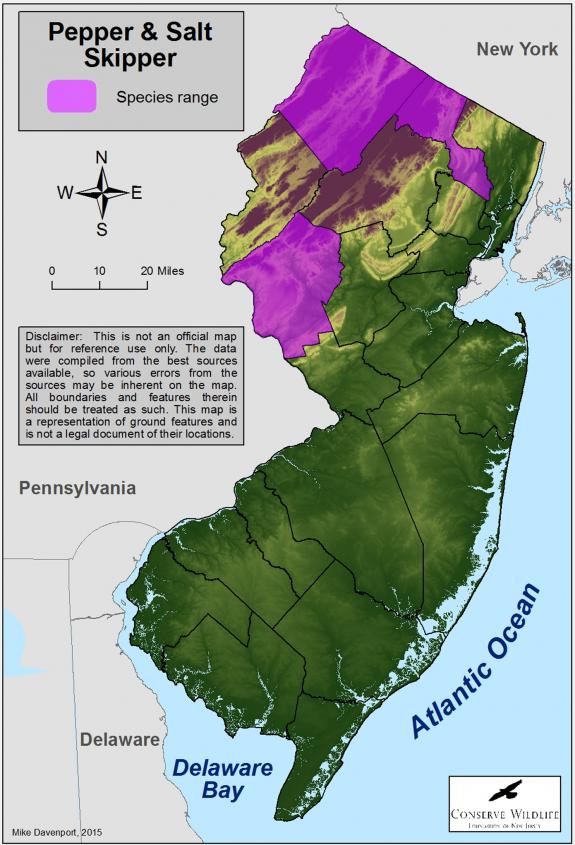Amblyscirtes hegon
Type: invertebrate
Status: not ranked
Species Guide
Pepper and salt skipper
Amblyscirtes hegon
Species Type: invertebrate
Conservation Status: not ranked
IDENTIFICATION
The pepper and salt skipper is named for its distinctive white-on-grey pattern on the hind wings. It can also be identified by looking at the greenish-yellow marking on the front wings. The pepper and salt skipper is often confused with the common roadside skipper. The underside of the pepper and salt skipper is reddish brown with pale spots. The male’s forewing has a black stigma attached. The underside of the hindwing is light gray-green with a pale band. The span of the wings can range from 1 to 1 3/16 inches. The fringe of the wings is checkered, especially the forewing.

Distribution & Habitat
The pepper and salt skipper is not found anywhere along the eastern coast of the U.S. Instead it is more commonly found in the forests of northern New England, Ontario and Quebec, as well as in the mountains of the southeastern states. It is rare and local within northern New Jersey.
This species is adaptable and widespread, however it prefers damp to medium-dry northern woodlands. They also prefer to live in medium to high elevations in mountainous areas. The ideal habitat for this species is openings in moist, deciduous or coniferous forests at moderate elevations. However, they have been seen in woodland glades, edges, roads and trails, and they are often near wet meadows or low-lying stream banks.
Diet
The caterpillars of this species often use many upland and wetland grasses such as bluegrass, Indian grass, and Indian woodoats grass as host species. Once the caterpillars become adult butterflies, they will begin to feed off of nectar from flowering plants. Some of the plants the adult pepper and salt skipper butterfly feeds off of are viburnum, geranium, and blackberry.
Life Cycle
The larva is pale green white with a dark green dorsal stripe and white lateral stripes; the head is dark brown with paler vertical stripes and bands. Little about the life cycle is known. During the pepper and salt skipper flight period it produces a spring brood. This occurs from late-May to mid-June. The overwintering stage is the larva.
Current Threats, Status, and Conservation
Currently, the pepper and salt skipper’s rank is S4 or probably secure in the core states of its range. These states include Pennsylvania, New York, Vermont, Massachusetts, New Hampshire, Maine, and the provinces of Ontario and Quebec. However, in some of the states on the boundary of its range we see a ranks of S3 or vulnerable in Connecticut and even an S1 or critically imperiled in Rhode Island.
In many of these states, there have been records of decline in population numbers over the past couple decades. Studies have shown there is a relationship between insecticide and pesticide spraying and decline in population number. Spraying of insecticides for gypsy moths and aerial insecticide spraying for mosquitos are two of the main causes of these declines. However, this is not believed to be the primary factor limiting these populations.
Along with insecticide spraying, this species can also be affected by the presence or absence of host plants. Without the proper plants for the larvae and adult butterfly, there may be declines in survival rates. It is believed that the main limiting factors are habitat, elevation, and climate. In order to conserve this species it is important to identify any unknown populations of the species. It could be helpful to begin protecting and conserving habitats that have yet to see declines. Also, restoration efforts should be put into effect in areas that are seeing a decrease in population size.
In 2015, the New Jersey Endangered and Nongame Advisory Committee recommended a Threatened status for this species within the state, but no formal rule proposal has been filed to date.
References
- The Butterflies of Massachusetts
- Butterflies and Moths of North America
- North American Butterfly Association, New Jersey Chapter
Text written by Michael Colella in 2015.
Scientific Classification
- Kingdom: Animalia
- Phylum: Arthropoda
- Class: Insecta
- Order: Lepidoptera
- Family: Hesperiidae
- Genus: Amblyscirtes
- Species: A. hegon